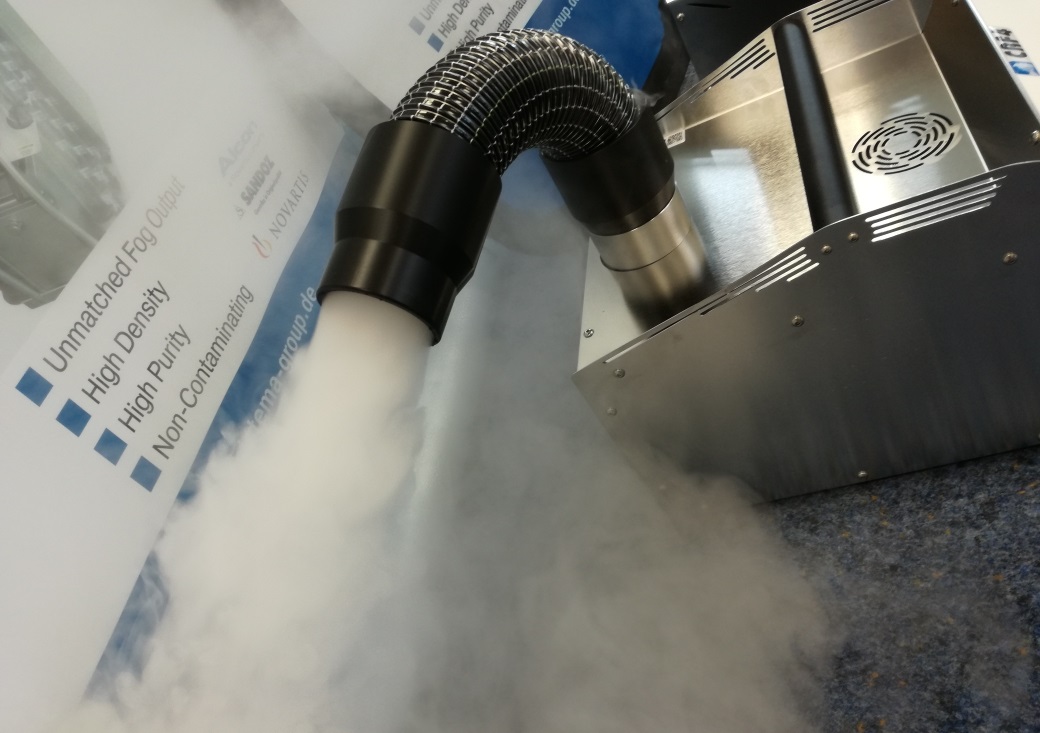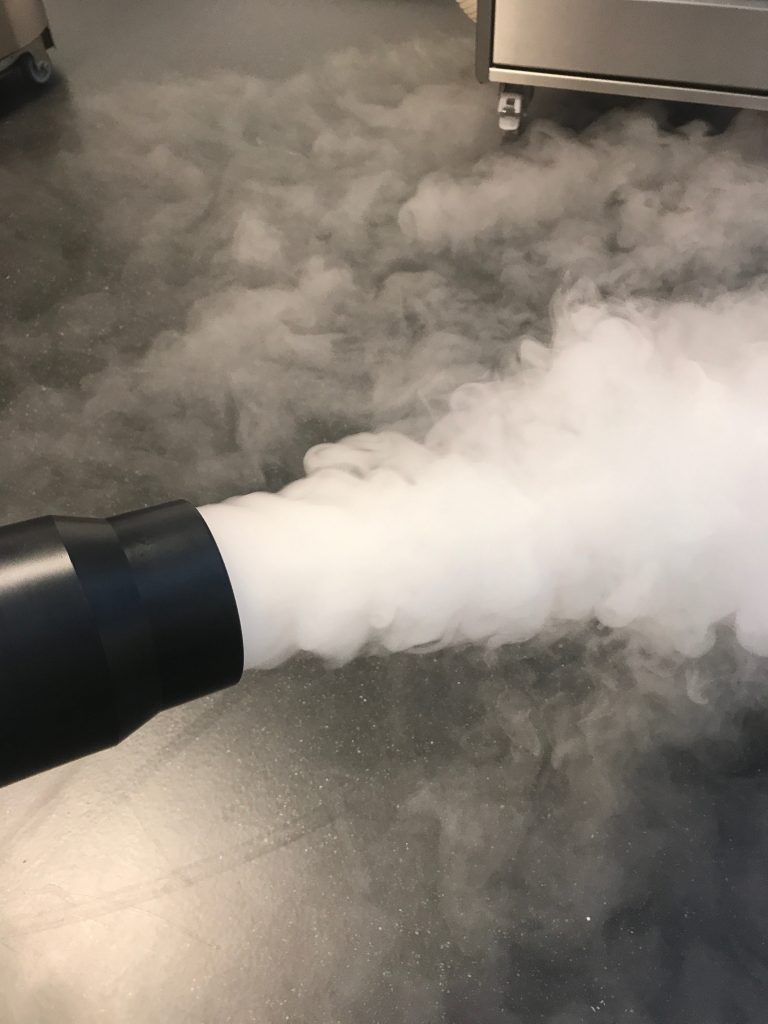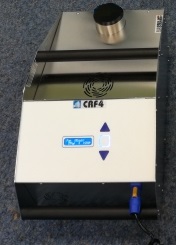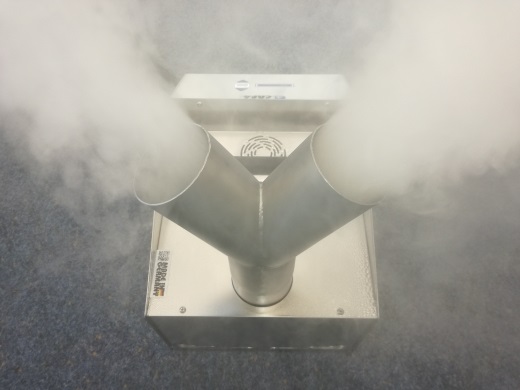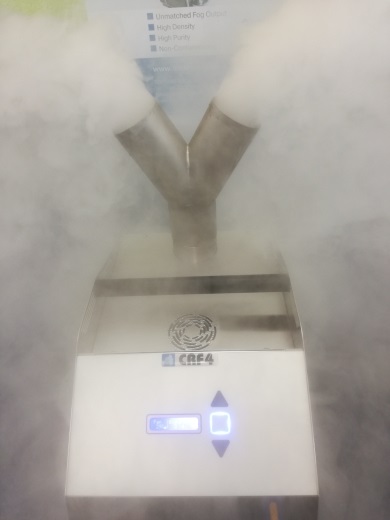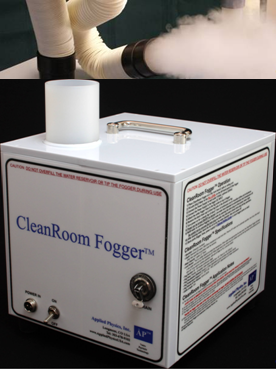The CRF4 Cleanroom Fogger uses 35 ultrasonic piezo devices to generate 1.25 cubic meters of pure fog per minute with 187 ml of fog density per minute to provide 10-15 feet of visible air flow for smoke studies and air flow characterization in clean rooms, sterile rooms, medical operating rooms and ISO suites. The CRF4 fog volume competes with LN2 foggers for fog volume performance. But the CRF4 does not use liquid nitrogen, requiring only DI Water or WFI water to produce this higher volume of fog, adding adjustable fog volume, adjustable airflow, and wireless remote control. The CRF4 operates for about 45 minutes at maximum fog volume or up to 90 minutes at lower fog volumes. The CRF4 supports USP 797 In-situ Airflow Analysis; USP 800 Compound Pharmacy airflow tests; Airflow Recovery Tests guided by ISO 14644-3, Annex B12; Airflow Visualization Tests guided by ISO 14644-3 Annex B7; airflow tests for NSF 49 and Bio-Safety Cabinets; and airflow requirements using Semiconductor Clean Room Guidelines, Federal Standard 209E.
CRF4 Cleanroom Fogger
Description
CRF4 Cleanroom Fogger produces 1.25 cubic meters fog per minute for 45 minutes and 10-15 feet of visual airflow – Request a Quote
Smoke studies and smoke tests to visualize airflow turbulence!
Cleanroom Fogger, CRF4 Features
- 35 ultrasonic piezos converting DI Water or WFI water directly to 1.25 cubic meters of pure fog per minute
- Quick refill of Di Water or WFI water for continuous fog use, Easy to Fill Water Port and Water Level feedback on the LED Display
- About 187 ml per minute of fog density to provide 10-15 feet of visible airflow
- Clean room fogger Handle for easy carry convenience
- Direct control of fog volume and air flow velocity
- Transducer life is 5000 hours
- 80 mm Diameter hose with a 15 foot length
- Fog Hose and 120 VAC Power Supply (or 220 VAC) is available, 15 foot power cable
- Easy to use, quick operation set up, instant On/Off fogging operation
- Fog Curtain Wand, optional, plugs into end of Fog Hose to create a wide, visual fog curtain
- Rolling Carry Case, optional, for carry and storage of fog generator and parts
- Wireless Remote Control Fob for remote operation behind closed walls
Smoke Tests in Pharmaceutical ISO Suites, Sterile Rooms, Medical Rooms, Semiconductor Clean Rooms
- Supports Recovery Test evaluation, 100:1 recovery time as defined in ISO 14644-3
- Supports airflow visualization tests for ISO 14644-3 ANNEX B7
- Supports airflow visualization analysis for Pharmaceutical USP 797 Guidelines
- Supports airflow visualization tests for NSF 49 National Safety Foundation
- Supports airflow visualization tests for the future USP 800 Hazardous Drug Compounding
- Supports airflow visualization tests for Semiconductor Semi-Standards Guidelines Federal Standard 209E
- Air flow balance
- Leak detection of exhaust ducts
- Barrier Isolator and laminar flow tests
- Wet bench exhaust tests
- Personal safety exhaust tests
- Chemical process equipment, exhaust ventilation tests
- Pressure balancing between rooms and spaces
- Visualization of airflow patterns and turbulence
CRF4 Cleanroom Fogger– Request a Quote
(Details)
|
GENERAL INFORMATION
The Cleanroom Fogger is used in a smoke study of airflow visualization. It is a significant improvement over other Di Water Foggers by providing the highest volume output of any ultrasonic fog generator sold today.
Theory of Operation: Ultrasonic cavitation in DI water, WFI (water for injection) or sterile water. Use of any other liquids or chemicals voids the warranty.
The transducer life is ~3,000 hours. To protect the transducers from damage there is a level sensor that will interrupt the input voltage to the transducer module, should the water level drop to a low level. This ensures long life and reliability.
Notes:
- The fog generated by this device contains microscopic droplets of DI water. AVOID USING IN IMMEDIATE VICINITY OF ELECTRICAL APPLIANCES, WATER SENSITIVE PRODUCTS AND EQUIPMENT.
- The fan will operate with no water in the reservoir with the power switch in the ON position. This will aid in drying when the chamber is drained.
- To drain water, simply disconnect power, and raise the CRF4 up and drain water from the fog opening.
- The CRF4 is intended to be used on a flat surface, on its feet. DO NOT OVERFILL THE CRF4.
Which Smoke Generator Is Best For My Smoke Studies?
* Use Hand Gloves and Face Shield when filling LN2 |
16 Meg ohm DI water is standard |
Fog Generator Technology
The three types of fog generators manufactured for use in the semiconductor and pharmaceutical industry are described below. Also discussed are Smoke Sticks and Glycol Foggers.
Ultrapure LN2 Fogger: This type of smoke generator or clean room fogger provides the highest volume, density and purity of fog. Vapor diameter is 1 to 3 micron diameter, and the fog density is very high by mixing water vapor and nitrogen vapor. Purity is created by bringing the water to a high temperature, creating a vapor, while simultaneously using gravity to remove the residual mass from the vapor. This process removes any bacterial agents and residual particulate matter from the vapor. The AP35 LN2 Fogger provides up to 5 cubic meters per minute for about 70 minutes using 1 to 2 fog hose outputs; while the AP100 produces about 15.5 cubic meters per minute for about 90 minutes using 2 to 4 fog hose outputs.
DI Water or Cleanroom Fogger: This type of ultrasonic fogger provides a typical vapor diameter ranging from 7 to 10 microns, depending on the piezo size diameter and ultrasonic frequency. The CRF4 Fogger produces as much fog as the smaller ultrapure foggers using only Deionized water, WFI water or sterilized water, making the CRF4 a very useful, less expensive tool to visualize airflow and turbulence in small areas as well as clean rooms. The CRF2 fogger produces more fog than a CO2 fogger below. The CRF2, when compared to a CO2 fogger, provides more fog volume, more fog density, longer visual airflows and costs about the same as a CO2 fogger.
CO2 Fogger: This type of smoke generator uses a CO2 ice combined with Deionized water, WFI water or sterilized water. The CO2 Fogger is portable to some degree, but produces a changing fog volume, from max fog volume at time “0”, and decreasing over a typical 8 minutes to zero fog volume. The fog generated is quite dense for the first 4 minutes, but as the CO2 ice evaporates, the fog volume decreases to zero, so the fog volume i9s not consistant. Many people like the CO2 fogger as it is a low cost approach to producing good fog during the first few minutes for video confirmation of smoke studies.








